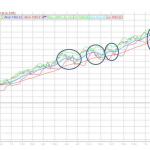Jeff Saut: Stock Market Appears To Be In Final Upside Blow-Off …

Money managers are unhappy because 70% of them are lagging the S&P 500 and see the end of another quarter approaching. Economists are unhappy because they do not know what to believe: this month’s forecast of a strong economy or last month’s forecast of a weak economy. Technicians are unhappy because the market refuses to correct and gets more and more extended. Foreigners are unhappy because due to their underinvested status in the US, they have missed the biggest double-play (a big currency move plus a big stock market move) in decades. The public is unhappy because they just plain missed out on the party after being scared into cash after the crash. It almost seems ungrateful for so many to be unhappy about a market that has done so well. . . . Unhappy people would prefer the market to correct to allow them to buy and feel happy, which is just the reason for a further rise. Frustrating the majority is the market’s primary goal.
–Bob Farrell, Merrill Lynch (9/5/1989)
I dredged up this quip from Merrill Lynch’s legendary strategist from an era gone by because it is just as applicable today as it was 25 years ago. I have used Bob Farrell’s writings a lot over the years because the wisdom they impart is timeless. I particularly like his “Everybody’s Unhappy” piece since that seems to be the mindset near inflection points — and I think we are near a short-term inflection point.
Last Friday I had this to say: “While there are no current major negatives from my indicators, this does indeed feel like the end of a trading move and not the beginning of another huge leg to the upside.”
What causes such inflection points is when the folks that have doubted the rally finally can’t stand it any more and they throw in the towel and buy stocks. To me, this phase of the melt-up started last week punctuated by 2%+ rallies in the S&P 600 SmallCap (NYSEARCA:SLY) (+2.79%), the Russell 2000 (INDEXRUSSELL:RUT) (+2.71%), and the S&P 400 MidCap (INDEXSP:SP400) (+2.35%). It should also again be mentioned that the near-term upside target zone, generated by the April 15, 2014 upside reversal day, was 1950 – 1975. Given Friday’s closing price of 1949.44 by the S&P 500 (INDEXSP:.INX), hereto the set up is about right for a short-term trading top between now and mid-July.
Then, there is this:
Recall, the SPX broke out to new highs in May 2013, and got some participants excited, but that breakout was followed by a 6.7% pullback into late June. Again in August of last year the same thing happened with a breakout to new highs followed by a 4.8% pullback. Once again that sequence played with a breakout to new highs in September 2013 with a 4.8% drawdown into mid-October. Even this year the pattern repeated with new highs in January and a subsequent 6.2% decline into the first week of February (see chart below). So we did get the anticipated 5% – 7% decline in the first three months of the year that the historical odds called for and now we will see if some kind of trading top will lead to the 10% – 12% pullback history calls for some time this year. It should be noted, however, all of these potential trading finesse moves are occurring within
the construct of a secular bull market that has years left to run.
The call for this week: If the equity markets don’t experience a sell-off this week, we can probably assume the SPX is in its final upside “blow-off” stage on a trading basis. In such a stage the markets make it seem unbearable to be in too much cash, or worse, totally out of the market. Blow-offs usually end with a parabolic peak and often with a buying climax. If you want to see what a buying climax looks like, go look at the selling climax at the March 2009 lows and turn the chart upside down. Longer term, I continue to hold the belief we are in a secular bull market, but in the short run, things are getting pretty stretched.
No positions in stocks mentioned.
Click Here to read the disclaimer >
The information on this website solely reflects the analysis of or opinion about the performance of securities and financial markets by the writers whose articles appear on the site. The views expressed by the writers are not necessarily the views of Minyanville Media, Inc. or members of its management. Nothing contained on the website is intended to constitute a recommendation or advice addressed to an individual investor or category of investors to purchase, sell or hold any security, or to take any action with respect to the prospective movement of the securities markets or to solicit the purchase or sale of any security. Any investment decisions must be made by the reader either individually or in consultation with his or her investment professional. Minyanville writers and staff may trade or hold positions in securities that are discussed in articles appearing on the website. Writers of articles are required to disclose whether they have a position in any stock or fund discussed in an article, but are not permitted to disclose the size or direction of the position. Nothing on this website is intended to solicit business of any kind for a writer’s business or fund. Minyanville management and staff as well as contributing writers will not respond to emails or other communications requesting investment advice.
Visit link:
Jeff Saut: Stock Market Appears To Be In Final Upside Blow-Off …
See which stocks are being affected by Social Media

